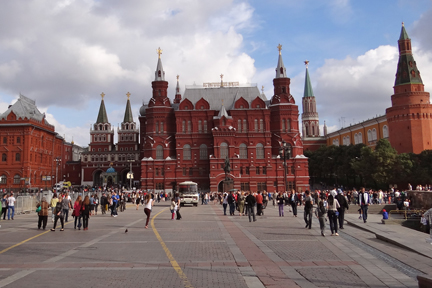We disembarked and began our two-day tour of Moscow.
We began at the Kremlin. Triangular and surrounded by crenellated walls, it occupies 90 acres. It is bounded on the south by the Moscow River and Kremlin quay, on the east by Red Square with Lenin's tomb, the Moscow Historical Museum, and St. Basil's Cathedral, and on the west and south by the old Alexander Gardens. The Kremlin's walls, built in the 15th cent., are topped on each side by seven towers (20 towers altogether).
In the center of the Kremlin is Cathedral Square, with the Assumption Cathedral (late 15th cent. but containing rare icons of the 12th and 14th cent.), which was used for czarist state occasions, for the crowning of czars, and for the burial of church patriarchs; the Annunciation Cathedral (15th–16th cent.), which served as the private chapel for the czars' families; the Archangel Cathedral (14th–17th cent.), which contains tombs of the czars.
RED SQUARE: The Russian word meant "beautiful" and was originally referring to St Basil's Cathedral. Eventually it became the name for the nearby square.
Red Square came into its own in the 20th Century, when it was most famous as the site of official military parades demonstrating to the world the might of the Soviet armed forces. Since Perestroika, however, the emphasis has moved away from official pomp, and Red Square has been used increasingly for rock concerts, big classical music performances and a whole range of large-scale events from fashion shows to festivals of circus art.

 |
| Lenin's Tomb on Red Square |
 |
| GUM's Department Store |
Gum's Department Store (pronounced GOOM). GUM today attracts around 15 million visitors per year to its more than 400 stores, cafes and cinema, laid out over three floors.
 |
| Novodevichy Convent |
Many churches were destroyed under communist rule. One such victim was the Cathedral of Christ the Saviour located in Moscow. Although plans started with Alexander I, his brother Nicholas I assumed power and sought a plan for the church more in keeping with Hagia Sophia. The cornerstone was laid in 1839 and it was completed in 1883.
Under the USSR religion was banned and the Cathedral of Christ the Saviour was demolished in 1931. In 1990 the Russian Orthodox Church received permission from the Soviet government to rebuild the cathedral. The completed rebuilt church was consecrated in 2000.
 |
| University of Moscow |
These are two of the seven sisters, part of a group of skyscrapers built between 1947 and 1953.
We had a great time even if we wouldn't read the signs.

















No comments:
Post a Comment